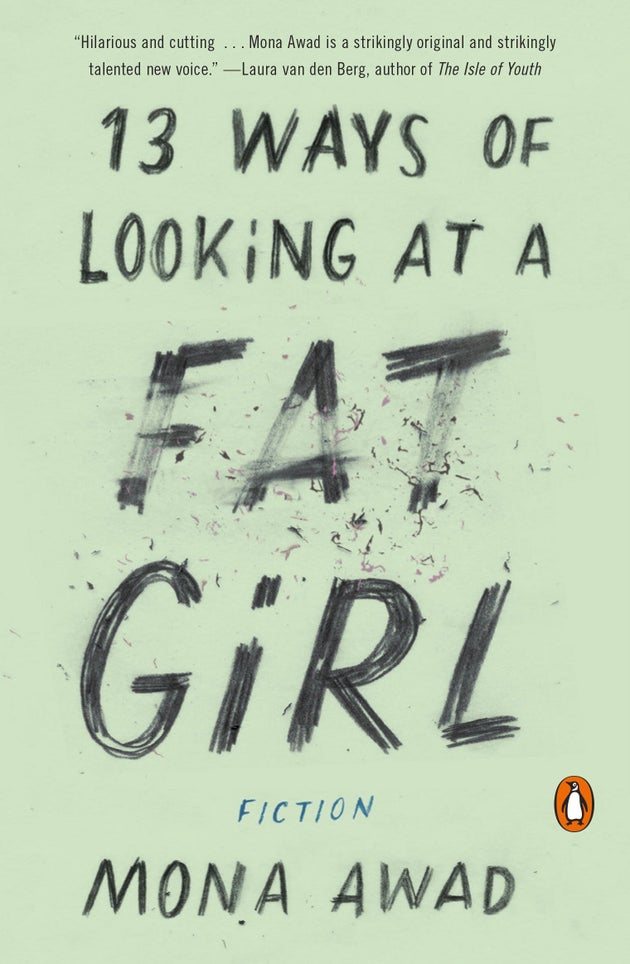
PENGUIN
Lizzie logs her days in lists. Four fluid ounces of alcohol, 12 almonds, one serving of quinoa. When she’s not pouring herself glasses of dry white wine, carefully tallying the calories in a measuring cup, she likes to watch TV, namely “America’s Next Top Model,” and anything cooking-related. She “watches the Food Network with a legal pad on her lap, taking notes for decadent meals [...] she’ll never make.”
The 28-year-old protagonist of Mona Awad’s new novel 13 Ways of Looking at a Fat Girl doesn’t sound like someone who’d struggle from body image issues. She has thick, dark hair and porcelain skin. Her curves fit neatly into society’s rigid beauty standards, and into the tight black dresses she wears for every occasion.
But her figure is the result of militant discipline -- veggie patties, handfuls of protein and bi-monthly enchilada splurges sculpt her once-overweight figure into the body she longed for growing up. And although she’s finally met her goal weight, Elizabeth’s fixation on food hasn’t waned. Her mood, and her self-esteem, are still wrapped up in her calorie intake. Cheat days bring her temporary happiness, followed by immense guilt. And her husband, Tom, wearies of food-centric habits, which get in the way of their once-satiating relationship.
“So much of Lizzie’s personality and so much of her conflict with her body, and so much of her story is bound up in how she sees herself and how others see her,” Awad said in an interview with The Huffington Post. In writing the book, she wanted to work against the notion that “fat” is a physical state that can change once pounds are shed. Instead, Awad says, weight is “a state of mind more than anything else, and it’s a hard one to break away from, a hard one to step out of.”
This idea is at odds with the countless weight narratives proliferated on reality TV shows and magazine covers. Shedding pounds is equated to winning -- an end goal rather than a step in some individual’s journey toward accepting and loving their bodies.
“So often the narrative around transformation is that it yields a happy ending, it’s like a fairy tale, and all is well in the end,” Awad said. “Once you’ve changed your body, that’s it, you’re happy.”
And Awad knows a thing or two about fairy tales. She wrote a dissertation on the topic while earning her master's in English literature.
“I’ve always been fascinated by fairy tales, in part because I think they’re so interesting in the way they play out our anxieties and desires, and in the way that the transformation is possible and very wondrous,” Awad said. “And I think that there’s something about the culture around body image that is creating the same sort of narrative, but in fairy tales it’s quite muddy. When the Little Mermaid becomes a woman, when she loses her fish tail, in Hans Christian Andersen’s version, every step hurts. There’s still pain. It’s not happy.”
Awad likens this rocky transition to her own struggle with body image, and the comparison is apparent in her protagonist, Lizzie. Before she reluctantly sheds pounds, favoring an at-home gym over homemade banana bread, she relates her love-hate -- but mostly hate-hate -- relationship with dressing rooms, a mythologized place where transformations can occur.
“In the dressing room she continually brings with her this hope. It’s never gonna go away totally. She has to go in there, we all have to go into the dressing room, we all have to cloak our bodies, we have no choice,” Awad said. “But there’s this hope that when she comes out of the dressing room she’ll be changed. That the new dress or whatever is going to perform this kind of magic.”
The nuance Awad adds to conceptions of weight and body image is applied also to her realizations of female friendships. Lizzie’s relationships with other women are at once petty and kind, jealous and admiring.
“I do think that body image can often come between women. It can be the subtext in a friendship, it can shape the way you might hang out with your friend, the way you might go shopping with your friend, the way you might have lunch with your friend,” Awad said. “The way you feel about your body when you’re standing next to your friend might change just by virtue of the fact that you’re standing next to her. What does that do to the quality of our friendships, the fact that women are mirrors for each other? I really wanted to tap into that.”
In doing so, Awad constructs a painful scene between Lizzie and a remarkably thin coworker, whom she secretly refers to as Itsy Bisty. The two often get lunch together, and Itsy Bitsy downs carbs while Lizzie laments wilted salad leaves. Discussing their relationship with another friend, Lizzie observes that her co-worker might just be her friend because of their weight difference. True to its cynical tone, the chapter is titled “The Girl I Hate.”
“I am interested in the ways that we’re cruel to each other because of our bodies,” Awad said. But, she added, what makes a story lovely is when it also explores “the moments when we’re tender with each other, in spite of our conflicted feelings.”
By Maddie Crum, the Huffington Post, February 29, 2016
No comments:
Post a Comment